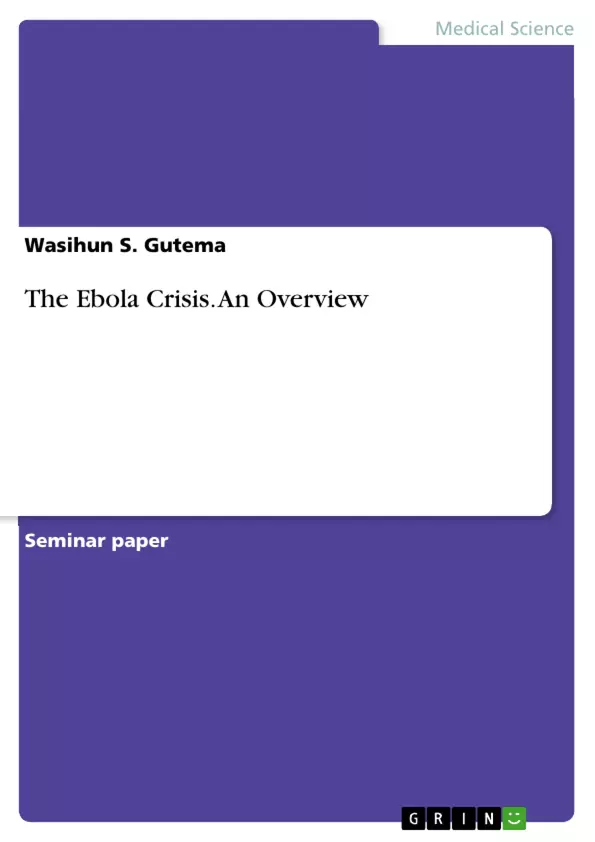This research paper explains what the Ebola Virus Diseases (EVD) is about and accounts of its history, centering on policy and administrative measures to tackle the EVD. In elucidating details of the EVD the research paper narrates aspects of when the virus was incepted in history and the origins of the virus. It also assesses controversies behind the origin of the virus and gives a conclusion that wild animals of unspecified type are the origin.
Its origin is unspecified given the fact that various wild animals are considered to be the root causes either as a contact or as food resources. Added, the paper details how the Ebola Virus Diseases of 2014 expanded beyond geographical barriers and affected huge numbers of people breaking the overall records in history and surpassing the overall past occurrences together in magnitude and scope.
The plague with such magnitude has shattered the capacity of Western African countries to contain it and put into question the ability of the world health organization (WHO) and the global community. Be that as it may, the collective participation of the global community has brought the plague into a defeat. The plague has been contained with the diverse role played by the international community, INGOs, WHO, the UN and the host West African countries of Guinea, Liberia and Sierra Leone. Guinea, Liberia and Sierra Leone have used different administrative and policy mechanisms to contain the Ebola Virus Disease of the 2014. The 2014 Ebola Crisis could not have been contained without those administrative and policy addressees that the host countries have designed and implemented.
The UN, WHO, and INGOs have also collaborated in containing the plagues with diverse administrative and policy issues besides providing resources to avert the farther expansion of the plague and its huge impact on security in its border term among which failure of investing on health facilities in West Africa was unprecedented. The research has finally drawn a recommendation and a conclusion.
Inhaltsverzeichnis (Table of Contents)
- Introduction
- I. Historical Back ground
- 1. Origin
- 2. Epidemiology.
- 3. The Ebola Virus Time Line………………………….
- II. The Ebla Crisis of the 2014 ....
- III. The Ebola Crisis of 2014 Actors, Policy and administrative addresses..
- 1. Liberia, Guinea, and Sierra Leone Policy and administrative addresses.
- 2. The UN and WHO Addressing the Ebola Crisis...........
- 3. INGOS
- Conclusion........
- References
Zielsetzung und Themenschwerpunkte (Objectives and Key Themes)
This research paper provides a comprehensive overview of the 2014 Ebola Virus Disease (EVD) crisis, focusing on its historical background, the timeline of outbreaks, and the policy and administrative measures implemented to contain it. The paper examines the origins of the virus, exploring different theories and concluding that wild animals of unspecified types are likely the source. It also analyzes the unique characteristics of the 2014 outbreak, highlighting its unprecedented scale and geographic spread.
- Historical context of the Ebola virus disease
- The origins and transmission of the Ebola virus
- The 2014 Ebola crisis: its magnitude and impact
- Policy and administrative responses to the outbreak
- The role of international organizations in containing the crisis
Zusammenfassung der Kapitel (Chapter Summaries)
The first section of the paper delves into the historical background of the Ebola virus, presenting conflicting accounts regarding its discovery and initial outbreaks. It highlights the significance of the 1976 outbreak, which marked the first documented human contact with the virus. The paper also explores the various theories surrounding the origin of the virus, concluding that wild animals are the most likely source.
The second section focuses on the timeline of Ebola outbreaks, emphasizing the 1976 outbreak as the first recorded instance of the virus's impact on humans. It also discusses the different types of Ebola virus identified based on their geographical origins.
The third section delves into the policy and administrative responses to the 2014 Ebola crisis, analyzing the measures implemented by the governments of Guinea, Liberia, and Sierra Leone to contain the pandemic. It also examines the roles played by the United Nations (UN), the World Health Organization (WHO), and various international non-governmental organizations (INGOs).
Schlüsselwörter (Keywords)
The research paper focuses on the Ebola Virus Disease (EVD), its historical context, and the global response to the 2014 crisis. Key terms include: Ebola Virus Disease, UN, WHO, INGOs, Guinea, Liberia, Sierra Leone, Security, policy, and administrative measures.
- Quote paper
- Wasihun S. Gutema (Author), 2016, The Ebola Crisis. An Overview, Munich, GRIN Verlag, https://www.grin.com/document/352228



